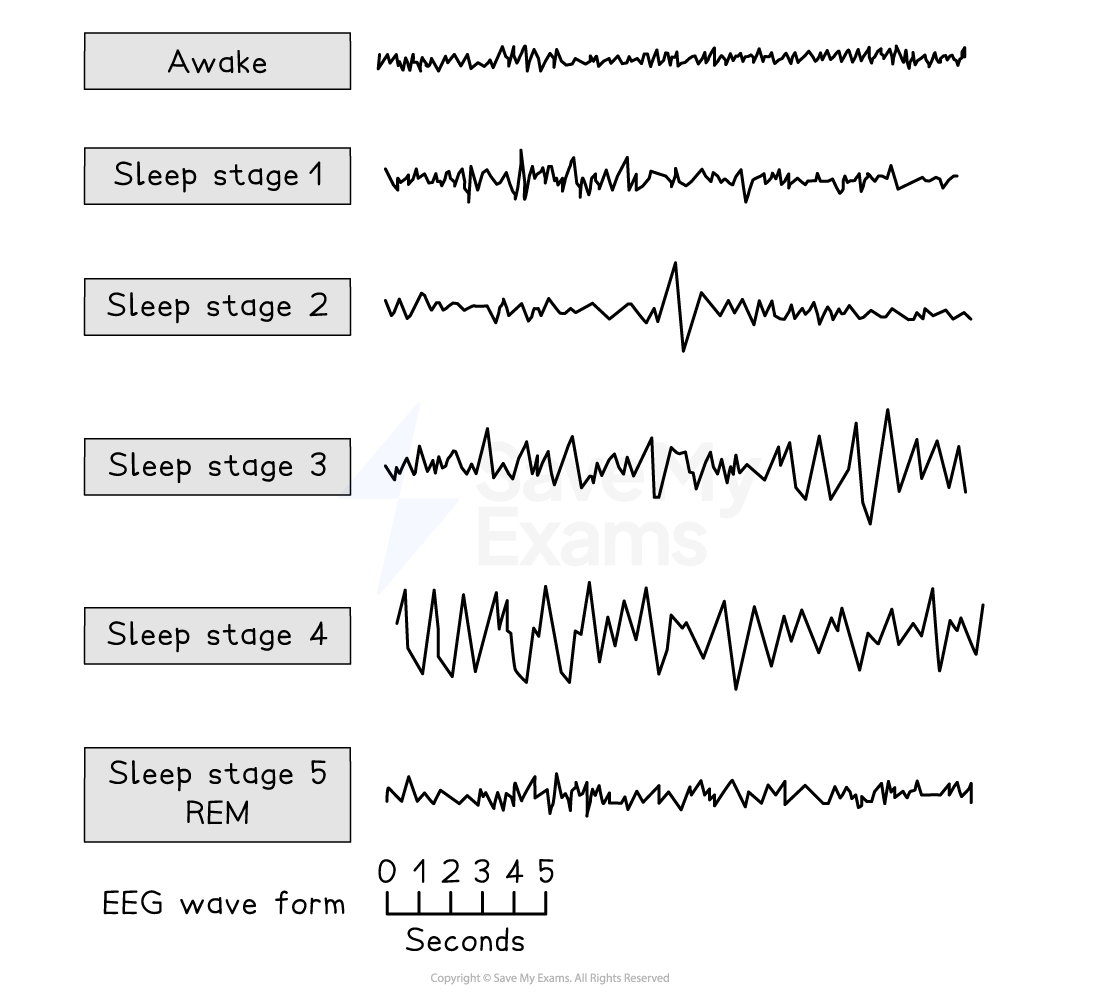Features of Sleep (OCR GCSE Psychology): Revision Note
Exam code: J203
Stages of sleep
Sleep follows a repeating cycle of five stages, lasting around 90 minutes
Throughout the night, we move through these stages multiple times
Stage 1: light sleep
Brain waves slow down: alpha waves become theta waves
Alpha and theta are types of brain waves
Alpha waves help us calm down
Theta waves promote deeper relaxation
People drift in and out of sleep, are drowsy and easy to wake
Eyes move slowly, and muscle spasms or the sensation of falling are common
Makes up around 5-10% of sleep
Stage 2: onset of sleep
Theta waves continue to slow with occasional bursts of rapid brain waves
Eye movement stops; heart rate and temperature drop
Conscious awareness of the outside world fades
Makes up about 45-50% of adult sleep
Stages 3 and 4: deep sleep (slow-wave sleep)
Stage 3:
There is a mix of slow delta waves with some faster waves
Delta waves are the slowest brain waves, most prominent during deep
Stage 4:
The brain produces only delta waves
It is hard to wake someone from deep sleep
There is no eye movement and reduced muscle activity
Growth hormone is released for physical repair
The body carries out immune system strengthening
Makes up about 20-25% of adult sleep
Stage 5: REM Sleep (rapid eye movement)
Brain waves are fast and resemble wakefulness
Eyes move rapidly and limbs are temporarily paralysed
Heart rate increases; breathing becomes quicker and irregular
Most vivid dreams occur here
People experience 3-5 intervals of REM sleep each night
REM periods get longer as the night progresses
Makes up about 20-25% of adult sleep

Examiner Tips and Tricks
When answering questions about REM sleep, go beyond simply stating that dreaming occurs. For a complete answer, ensure you can outline the following additional features:
changes to breathing: breathing becomes quicker and irregular
limb paralysis to prevent acting out dreams
brain waves are similar to being awake
Focus on these three unique physiological characteristics for a detailed response.
Endogenous pacemakers (EPs) & exogenous zeitgebers (EZs)
Our 24-hour sleep–wake cycle is regulated by both:
endogenous pacemakers: internal biological clocks
exogenous zeitgebers: external cues (e.g., light)
They interact to keep our circadian rhythm stable
Endogenous pacemakers
These are internal body clocks that regulate or control biological rhythms
A key factor in how we sleep is exposure to light or darkness
The key pacemaker is known as the Suprachiasmatic Nucleus (SCN)
Suprachiasmatic nucleus (SCN)
The SCN is a part of the brain that regulates circadian rhythms
It is located in the hypothalamus
It receives information about light via the optic nerve
The SCN sends signals to other parts of the brain that regulate:
hormone release, i.e. melatonin
body temperature
alertness/tiredness
Pineal gland
The pineal gland is a small endocrine gland found in the brain
It is activated by the SCN when it gets dark
The pineal gland produces and releases melatonin
Melatonin
Melatonin is a natural hormone linked to sleep onset
Levels rise in the evening, making us sleepy
They remain high for about 12 hours through the night
Melatonin drops to very low levels during the day
This hormone helps regulate the circadian rhythm
Melatonin production can be disrupted by:
shift work
screen use at night
jet lag/time zone changes
Exogenous zeitgebers
Exogenous zeitgebers are external cues that influence the sleep–wake cycle
The main zeitgeber is light
Light resets the SCN each day
Darkness triggers melatonin release (promotes sleep)
Light suppresses melatonin, which makes us more alert
Other zeitgebers include:
social cues (noise, activity)
temperature
mealtimes
Examiner Tips and Tricks
For a top-grade answer on the pineal gland's role in the sleep/wake cycle, avoid simply mentioning melatonin release.
Ensure your explanation covers the mechanism:
The pineal gland is 'switched on' at night by the SCN
This activation is a direct result of low levels of light detected by the eyes
This trigger causes the pineal gland to release melatonin at night, inducing sleepiness
Focus on the SCN-light-melatonin pathway for a complete answer.

Unlock more, it's free!
Did this page help you?